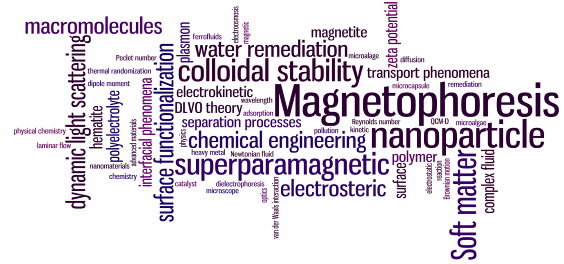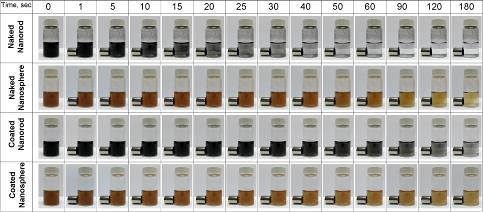

|
Current research |

|
Magnetic Nanohybrid Materials |
|
Magnetophoresis and Colloidal Stability of Magnetic Nanoparticles |

|
Home | Research | People | Publications | Outreach | Related Links |
|
Rapid magnetophoretic separation of microalgae |
|
In this project we have successfully demonstrated the possibility to magnetophoretically harvest microalgae from its culture media under the influences of low magnetic field gradient. We take advantages of both colloidal stability and magneto-shape anisotropy of MNP to achieve rapid separation of the microalgae Chlorella sp. in real time under the influences of a NdFeB magnet with surface magnetization field ~ 6000 G (see movie above). We are also investigating the particle-to-cell interactions involved in dictating the successful attachment of MNPs on to microalgal cells. Our focus is on the role of Lewis Acid-Base interactions under high ionic strength condition.
Most recent publications on this topic: 1. C.C. Chai, Z.H. Lee, P.Y. Toh, C.J.C. Derek, A.L. Ahmad, J.K. Lim, “Effects of dissolved organic matter and suspended solids on the magnetophoretic separation of microalgal cells from an aqueous environment” Chemical Engineering Journal 281 (2015) 523—530. 2. P.Y. Toh, B.W. Ng, A.L. Ahmad, C.J.C. Derek, J.K. Lim, “The role of particle-to-cell interactions in dictating the nanoparticle aided magnetophoretic separation of microalgal cell”, Nanoscale 6 (2014) 12838—12848. 3. P.Y. Toh, B.W. Ng, C.H. Chong, A.L. Ahmad, J.W. Yang, C.J.C. Derek, J.K. Lim, “Magnetophoretic separation of microalgae: the role of nanoparticles and polymer binder in harvesting biofuel”, RSC Advances 4 (2014) 4114—4121. 4. J.K. Lim, C.J.C. Derek, S.A. Jalak, P.Y. Toh, N.H. Yasin, B.W. Ng, A.L. Ahmad, “Rapid Magnetophoretic Separation of Microalgae”, Small 8 (2012) 1683—1692. |
|
MNP-polymer hybrid materials |
|
In this project we have successfully synthesized (1) silica-core iron oxide shell nanocomposite with polymer as intermediate layer, and, (2) encapsulation of spherical and rod-liked Fe0/iron oxides nanoparticles into Polyvinylidene Fluoride (PVDF) polymeric microcapsule. This species of hybrid nanomaterial is capable of removing pollutants from water resources through two mechanisms: adsorption by polymeric network/MNP and catalytic degradation by MNP. The capability of this nanocomposite (which possesses both magnetic and catalytic properties) for removal of various organic and inorganic pollutant from water resources have been verified. We’re currently working on a mathematical model, by simultaneously solving diffusion-reaction and diffusion-adsorption equations, to identify the major driving mechanism of pollutant removal process.
Most recent publications on this topic: 1. S.P. Yeap, A.L. Ahmad, B.S. Ooi, J.K. Lim, “Manipulating cluster size of polyanion-stabilized Fe3O4 magnetic nanoparticle clusters via electrostatic-mediated assembly for tunable magnetophoresis behavior”, Journal of Nanoparticle Research 17 (2015) 403. 2. H.X. Che, S.P. Yeap, M.S. Osman, A.L. Ahmad, J.K. Lim, “Directed assembly of bifunctional silica-iron oxide nanocomposite with open shell structure”, ACS Applied Materials & Interfaces 6 (2014) 16508—16518. 3. H.X. Che, S.P. Yeap, A.L. Ahmad, J.K. Lim, “Layer-by-layer assembly of iron oxide magnetic nanoparticles decorated silica colloid for water remediation”, Chemical Engineering Journal 243 (2014) 68—78. 4. L.P. Kong, X.J. Gan, A.L. Ahmad, B.H. Hameed, E.R. Evarts, B.S. Ooi, J.K. Lim, “Design and synthesis of magnetic nanoparticles augmented microcapsule with catalytic and magnetic bifunctionalities for dye removal”, Chemical Engineering Journal 197 (2012) 350—358. |
|
Low gradient magnetophoresis of MNPs |
|
This is the core project of our group in which we have been working on it since 2008. The idea is to understand the transport behavior of magnetic nanoparticles under the influences of low field gradient. The colloidal behavior of this MNP is monitored by dynamic light scattering (DLS), electrophoretic mobility measurement, and an custom built experimental setup based upon LDR technology. Moreover, quartz crystal microbalance with dissipation (QCM-D) is employed to study the adsorption of macromolecules onto iron oxide surfaces. We are also relying on computational fluid dynamics simulation to investigate the fluid related transport behavior of MNPs. Our current focus is on the role of colloidal stability of MNP and hydrodynamic effects on magnetophoretic behavior(s).
Most recent publications on this topic: 1. S.S. Leong, Z. Ahmad, J.K. Lim, “Magnetophoresis of superparamagnetic nanoparticle at low field gradient: hydrodynamic effect”, Soft Matter 11 (2015) 6968—-6980. 2. S.P. Yeap, S.S. Leong, A.L. Ahmad, B.S. Ooi, J.K. Lim, “On size fractionation of iron oxide nanoclusters by low magnetic field gradient”, The Journal of Physical Chemistry C 118 (2014) 24042—24054. 3. J.K. Lim, S.P. Yeap, C.H. Low, P.Y. Toh, S.C. Low, “Magnetophoresis of iron oxide nanoparticles at low field gradient: the role of shape anisotropy”, Journal of Colloid and Interface Science 421 (2014) 170—177. 4. S.P. Yeap, P.Y. Toh, A.L. Ahmad, S.C. Low, S.A. Majetich, J.K. Lim, “Colloidal stability and magnetophoresis of gold-coated iron oxide nanorods in biological media”, Journal of Physical Chemistry C 116 (2012) 22561—22569. 5. S.P. Yeap, A.L. Ahmad, B.S. Ooi, J.K. Lim, “Electrosteric stabilization and its role on cooperative magnetophoresis of colloidal magnetic nanoparticles”, Langmuir 28 (2012) 14878—14891. |
|
We are currently looking for highly motivated graduate and undergraduate students to undertake experimental and theoretical studies on magnetic nanoparticles. There are multiple opening for the projects listed on this page. Interested candidate please kindly send a copy of your CV to JK Lim at chjitkangl@usm.my. |


